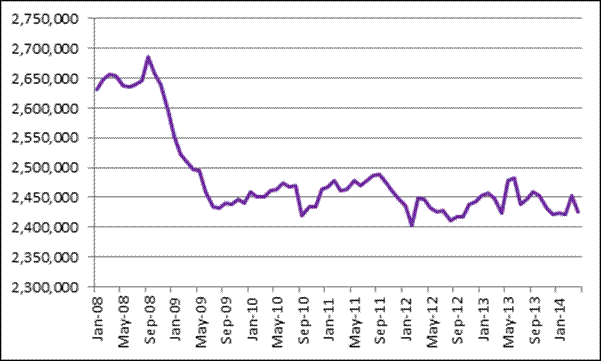FINA Committee Report
If you have any questions or comments regarding the accessibility of this publication, please contact us at accessible@parl.gc.ca.
SUPPLEMENTARY OPINION OF THE LIBERAL PARTYThe Liberal Party would like to thank the many individuals and organizations from across Canada who came forward to share their expertise with the Committee during this study. We generally support the findings and recommendations of this report. However, there are a few key areas where the majority report glossed over some important challenges facing Canada. A. Job Creation for Young CanadiansToo many young Canadians are not sharing in Canada’s economic prosperity. Though some sectors of the population have recovered from the recession, youth employment remains stubbornly below pre-recession levels. There are still 259,200 fewer jobs for young Canadians compared to the autumn of 2008. Youth employment in Canada (15-24 years of age), 2008–present
Source: Statistics Canada, Table 282-0087, “Labour Force Survey estimates (LFS), by sex and age group, seasonally adjusted, monthly,” CANSIM (database), accessed on 5 June 2014. Given the depth of the challenges facing our youth, the federal government ought to show leadership and help create job opportunities for young Canadians. Instead, the Conservatives cut $98 million in funding to the Youth Employment Strategy (YES) which is the government’s flagship program for stimulating youth employment. They have also cut the number of student jobs created through the Canada Summer Jobs Program by more than half since taking office (36,000 student jobs in 2013-14 compared to 77,579 student jobs in 2005-06). B. The Government of Canada as an EmployerThe Conservative government is also making the situation worse in their role as an employer. Despite the fact that young Canadians face an already weak labour market, the government is continuing to cut the number of student jobs in the federal public service. Student jobs in the federal public service
Source: Public Service Commission of Canada, Annual Reports (2009-10 to 2012-13) The federal government hires students mainly through two programs: the Federal Student Work Experience Program (FSWEP) and the Co-operative Education and Internship Program (Co-op). Both programs provide full-time students with paid, temporary work and valuable job experience. Over the last four years, the number of positions in the FSWEP and Co-op programs has been cut by 39 percent and 30 percent, respectively. C. Financial impact on parentsYouth unemployment and underemployment not only hurts young Canadians, it also places a financial strain on their parents. The Canadian Alliance of Student Associations recently sponsored a national survey of parental views on post-secondary education. It shows that 33 percent of Canadian parents are using their retirement savings to help pay for their children’s school, and one out of seven parents are even remortgaging their homes. The same survey also shows that 70 percent of parents feel a responsibility to allow their adult children to live at home so that their children can save money. An earlier survey by TD Canada Trust shows that a majority of baby boomer parents have financially supported their adult children, even after graduation. This includes 43 percent of parents who have let their adult children live at home rent-free after finishing school. According to John Tracy, Senior Vice President at TD Canada Trust:
Data from the Canadian Financial Monitor shows that baby boomer parents now carry twice as much household debt, on average, as their childless peers. D. Aboriginal YouthAboriginal peoples are Canada’s youngest and fastest growing population. They represent tremendous economic potential. Yet only one in three First Nations students on-reserve are graduating high school. While education generally falls under provincial jurisdiction, the federal government retains responsibility for education on reserves. Nevertheless, the Conservatives have left on-reserve schools chronically underfunded and in a state of disrepair. Even with the new funding announced in the latest federal budget, there remains a sizeable funding gap between on-reserve schools and provincially-funded schools in rural and remote areas. If the economic potential of Aboriginal peoples is to be fully realized, the federal government must work in partnership with Aboriginal communities to eliminate this funding gap. Finally, we agree with witnesses who testified that a shortage of affordable childcare, both on and off reserves, acts as a barrier to young parents who want to enter the workforce or upgrade their skills. RECOMMENDATIONS The Liberal Party recommends:
|
